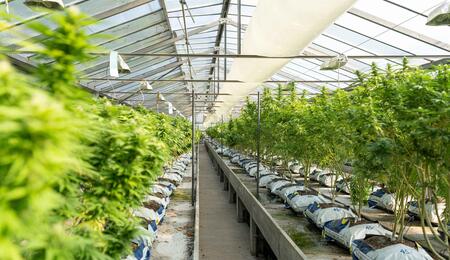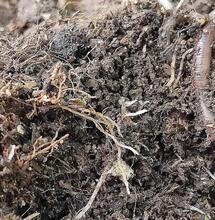Organic VS Hydroponics - What Is The Difference?

Cannabis plants are extremely well adapted to being grown in both organic substrate or a hydroponic medium. There are advantages and disadvantages associated with either, so in this article we explain the main differences and benefits associated with allowing you to see which may be best suited for you.
Growing Cannabis with Organic Methods
Working with an organic substrate such as soil or compost and liquid nutrients is typically the entry-level point for a beginner grower. Often times those who prefer a chemical free, natural flavor will stick to growing organically grown Cannabis for peace of mind,
There is a buffering zone that operates in the soil that allows any liquid or hard food to be broken down over a 72-hour period. This essentially gives an amateur grower much more room for error in comparison to the almost instant results hydroponics produce.
The most basic way to grow organic Cannabis is to simply add a molasses solution and allow the soil to do the rest. Molasses or fish emulsion are rich in carbon and are exactly what the beneficial bacteria and mycorrhizal fungi present require. In exchange, the soil food web is kept optimal ensuring that any nutrient the Cannabis plants need during their life cycle is provided.
- Beginner-level growers will normally start using organics and may shift to hydroponics.
- Organic Cannabis is the cleanest form of medicine and ensures it is chemical free.
Skill Level
Organic Cannabis is simply a particular way to grow the cleanest flower possible that is contaminant and pesticide free. As far as prior experience and skill level are concerned, organically grown plants can simply be placed on a basic diet of plain water or a nutrient solution.
- Perfect for beginner or long-term growers.
- Watering every 1-2 days when the pots are dry.
- Use only plain water or a nutrient solution.
- There is no need to pH the nutrients using pH up or down.
- Growing organic Cannabis outdoors can be straightforward.
Expenses
One of the main advantages of growing organic Cannabis is the initial investment is comfortably affordable. There are many great brands that offer a soil mix and liquid nutrients to accompany on a tight budget, and even customizing your own organic blend using soil, compost, worm castings, coco, and others is easy to do.
Once your pots are filled with soil and you have invested in your next lot of seeds, there really is not much more to purchase. Furthermore, once you understand how the soil food web works and the symbiotic relationship with mycorrhizal fungi, recycling your organic medium and using it again saves time and money. Expert organic farmers never throw their soil out and will only supplement it with top dressing compost, organic compost teas, and fish emulsion.
The Advantages Associated
- Many growers believe that organically grown Cannabis has the best taste.
- The perfect starting point for an indoor or outdoor grower.
- 50 liters of soil and organic nutrients will cost around Є50-Є75.
- Soil can be recycled for many more years, saving a carbon footprint.
- Organic Cannabis provides peace of mind and the cleanest medicine.
- Working with organics over a long time frame saves money and time.
- The buffering zone of 72 hours is much more forgiving than hydroponics.
Growing Cannabis Using Hydroponic Methods
Hydroponics simply means to grow with a soilless medium, which can range from rockwool, coco, perlite, and hydroton. As the growing medium is inert and contains zero nutrients, it is in the hands of the grower to feed the optimal ratio at the right time.
Commercial-scale facilities that grow Cannabis or vegetables such as tomatoes, understand the large-scale application that hydroponics can be applied to. The practicality side of things allows facilities to run enormous sized crops using staff to maintain the systems and plants.
Growing Cannabis using hydroponic methods has many advantages once you are target driven and focusing on production value, third-party investors and profit margins. Hydroponics are well suited for indoor growers with limited space who are adamant they want the biggest yields possible. Below is a list of the various hydroponic systems and what they require.
Dripper Systems: This method of farming is extremely popular across the world and involves placing a drip stake into the growing medium. The dripper line is connected to a nutrient solution that runs off a timer. Feeding can occur 3-5 per day depending on the lifecycle.
Flood and Drain: These work using a table that fills with nutrient solution and drains away. The substrate used will typically be hydroton clay balls that allow the solution to easily drain. There is only a small amount of hydroton required and feeding can occur 3-5 times per day.
Deep Water Culture: One of the most rewarding systems that also requires the most amount of maintenance. DWC systems allow the roots to suspend in a bucket that is filled with nutrient solution and an air stone or hose. The roots have access to the nutrients 24 hours a day.
Aeroponics: Using a pump and a spray nozzle, the roots of a Cannabis plant are suspended into a chamber that is kept in darkness and misted. For 15 minutes every hour the spray nozzles will turn on. The plants are exposed to air for the other 45 and this is repeated.
N.F.T Table: These systems are an old-school way to grow Cannabis, that allows the roots to grow down onto a table. There is a constant flow of nutrient solution provided 24 hours a day, and these systems make very little noise and produce huge yields.
Skill Level
Unlike stepping straight into an organic garden, growing Cannabis using hydroponics demands much more maintenance, skill, and a thorough understanding of pH, E.C, and feeding regimes.
- E.C and pH meters need to be used for every single feeding.
- Nutrient solution may need to adjust up or down.
- Deficiency or toxicity problems can occur far quicker than with organics.
- It is essential to keep your systems clean, sterile, and free of pathogens.
Expenses
Hydroponic systems can vary in price and size, ranging from systems ideal for a 1 meter squared tent such as DWC systems, 4-pot dripper systems, small NFT, and flood and drain tables. If you wish to replicate a commercial-scale facility then the initial expense may be at a premium, however the return on investment is well worth it.
A home grower can easily start with an entry-level system such as an N.F.T table or dripper system and purchase the relevant nutrients for around Є100-150. Slightly more of a start up cost than growing organic Cannabis, however not a bank breaker.
The Advantages Associated
- The yields hydroponic systems produce can be 3-4 times more than organically grown.
- The systems save watering and physical labor and only require maintaining.
- One small system can produce incredible results if you need to reduce plant count.
- Hydroponic systems are easy to customize and can be made from store bought items.
- Feeding times will increase from 3-5 times per day resulting in big plants and buds.
- The flavor may not be as refined as organic Cannabis, but others will disagree.







